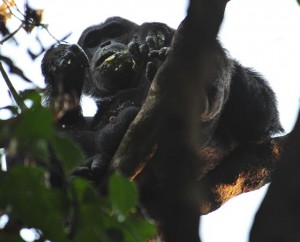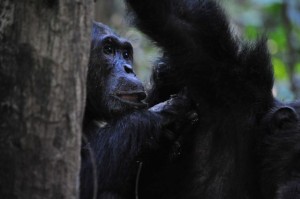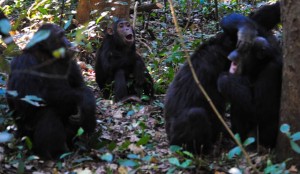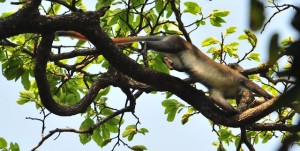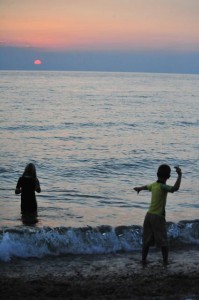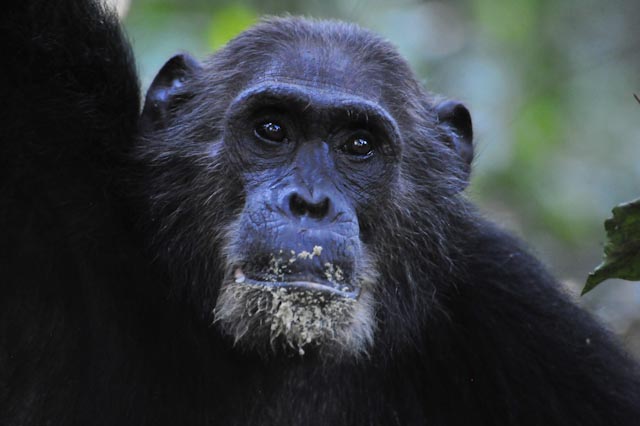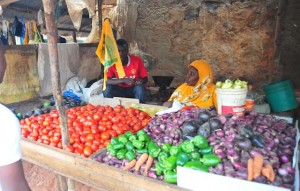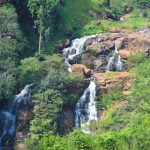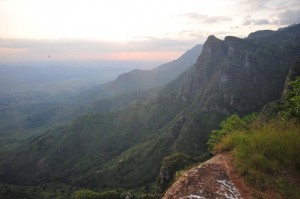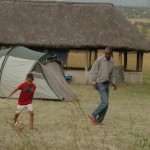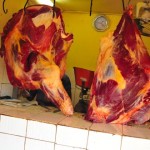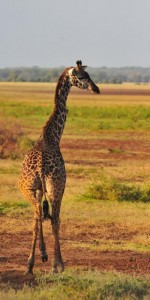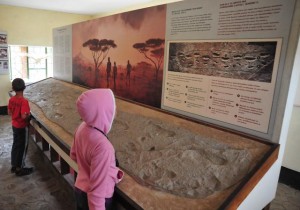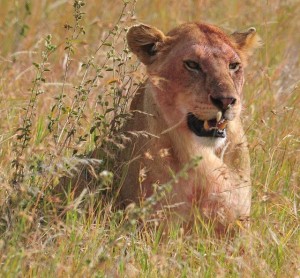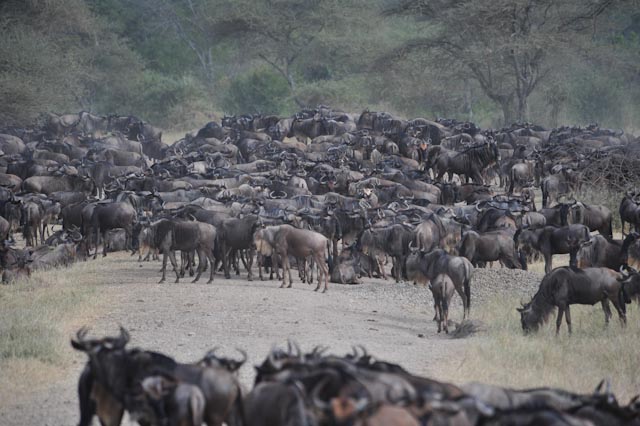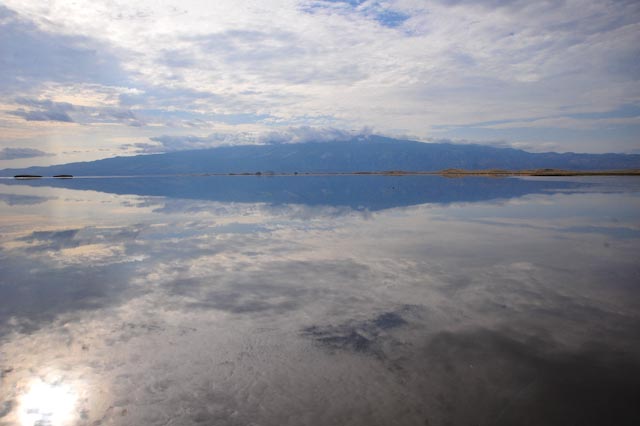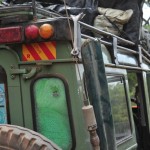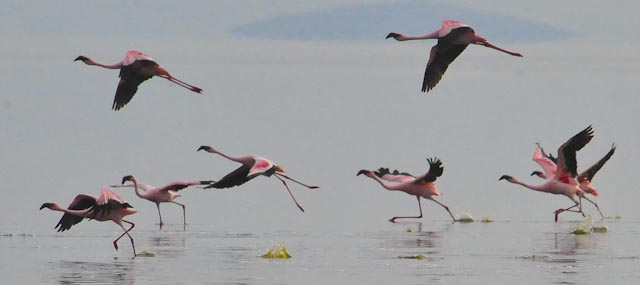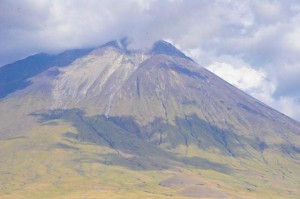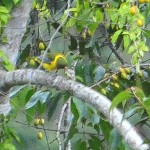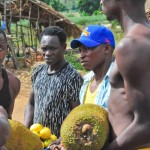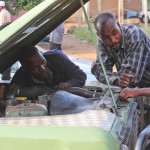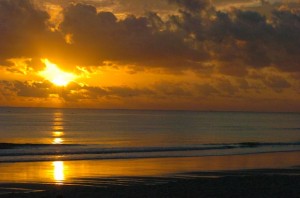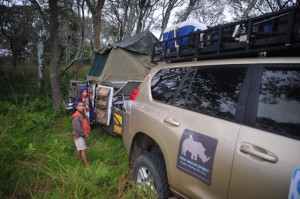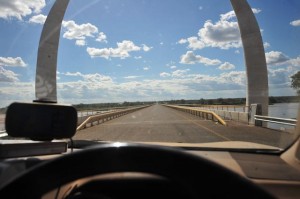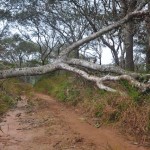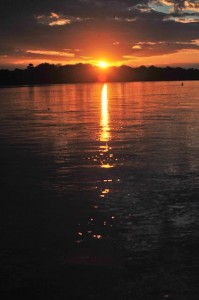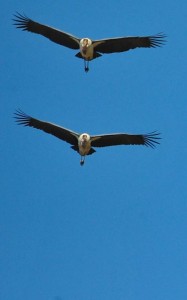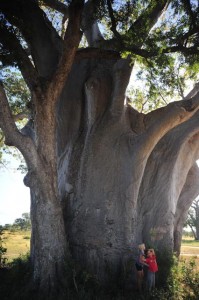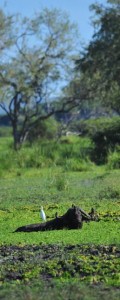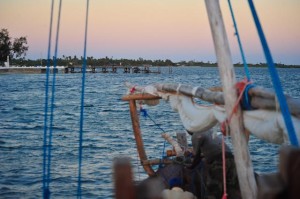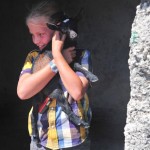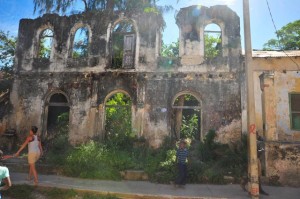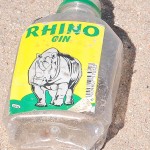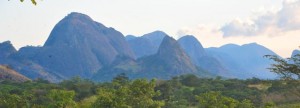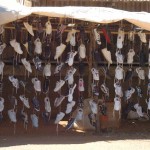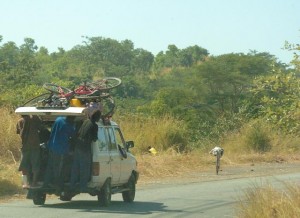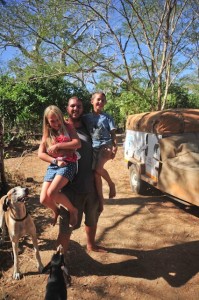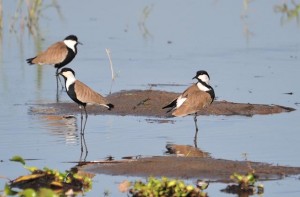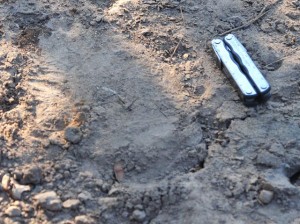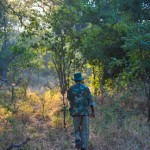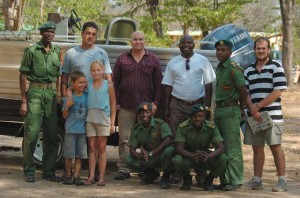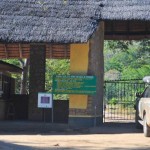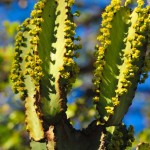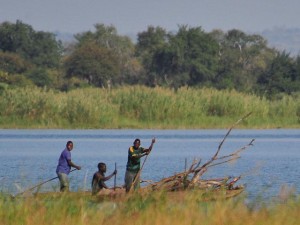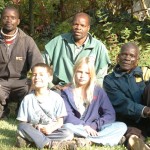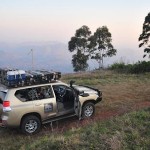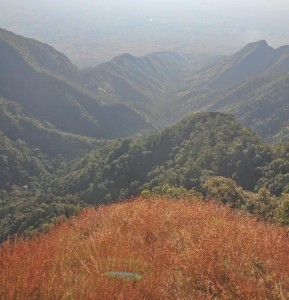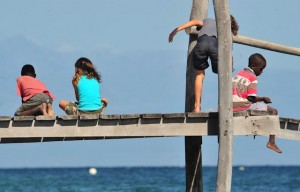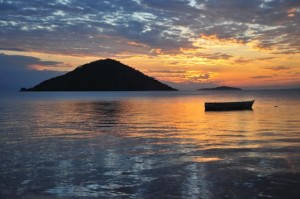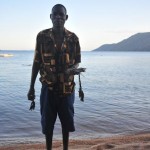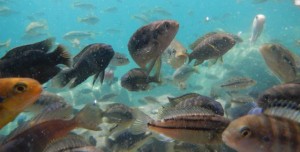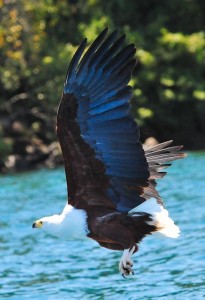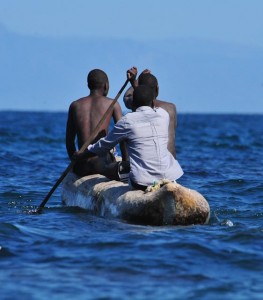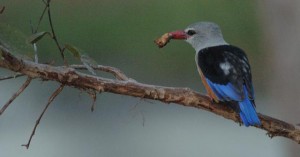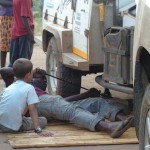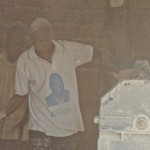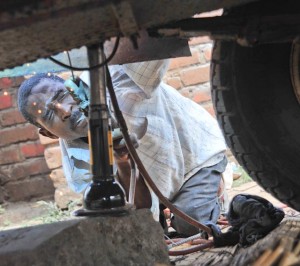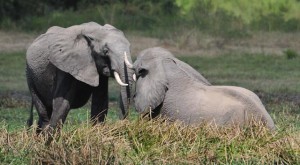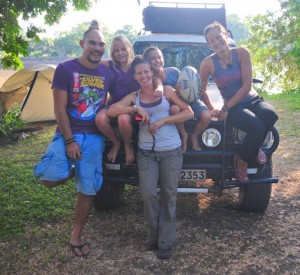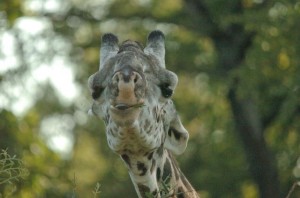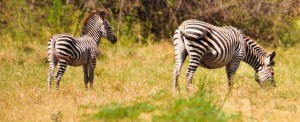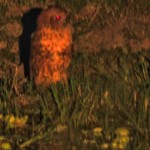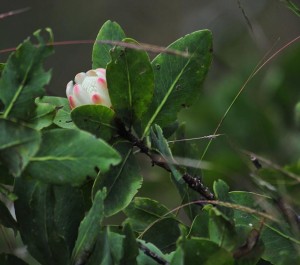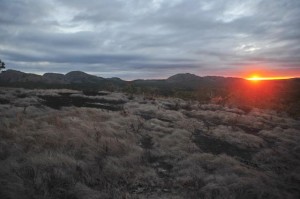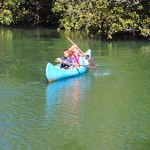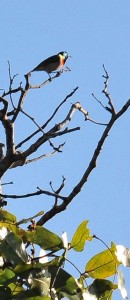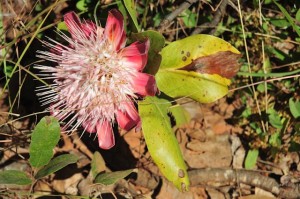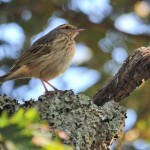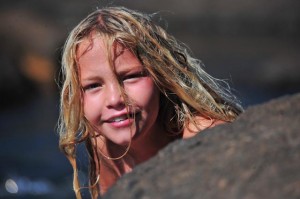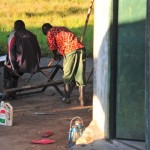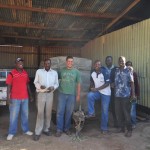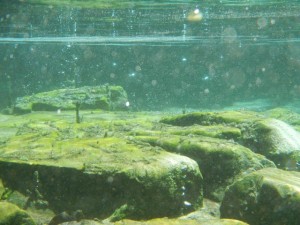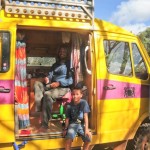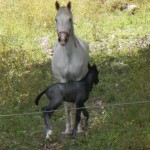Cape to Cairo Journey:
Pages to Explore:
Blog Catagories:
Photo of the day








Home | About Us | Safaris & Photographic Trips | Blog | Contact Us | Sitemap | Disclaimer
The Essence of the Journey!
We would like to do this trip to experience new cultures.
We would like to understand what makes African people pure.
What are their spiritual beliefs, understandings?
How does the spiritual world we know exist to them?
What can we learn from them?

Gombe – North Western Tanzania:
It took four days to get from Dar es Salaam to Kigoma and then 3h15 on boat from Kigoma to Gombe (tired single engine 38HP ŌĆō access only by boat).┬Ā We really wanted to get to Gombe, so we did.┬Ā Lake Tanganyika is the longest Lake in the world and the second biggest.
Sometimes one builds up expectations of something fantabulous and then it suddenly ends in a damp squib.┬Ā Geneally it manifests later, sometimes unnoticed.┬Ā We had read one of JaneŌĆÖs books together as a family ŌĆśMy Life with the ChimpanzeesŌĆÖ, we were all pumped.┬Ā How would Chimpanzee trekking in Gombe pan-out?┬Ā We were staying at Jane GoodallŌĆÖs cottage for 30 years whilst she was working at Gombe.┬Ā Here she had spent many late nights pouring over years of data, it really had a good vibe to it.┬Ā
I awoke early the next morning, Red Headed Robin Chat calling, waves lapping on the smooth pebbled shore of Lake Tanganyika.┬Ā The forest was still, silent, there were no primates calling yet.┬Ā Times at Gombe had changed ŌĆō no longer do you go out pre-dawn to where the chimps had nested, and then follow them.┬Ā┬Ā Nowadays a tracker goes out around 07h00, and then radios the guide, so that when you leave at 08h30, the likelihood of seeing chimps is practically guaranteed.┬Ā At just over 52 km2, Gombe is TanzaniaŌĆÖs smallest Park.┬Ā It is steep and houses 3 chimpanzee communities.┬Ā The Kasakela community is the central community and comprises 56 members, which have been habituated to humans and most easily visited.
We trekked into the forest, coming across Ferdinand the alpha male, feeding on the ripening fruits of the Mubungo (Vinnes sabbaflorida). ┬ĀHe, together with two other males close by, spent almost an hour feeding.┬Ā He did not forage far, and seemed to get all the fruits he needed within 15 metres from his original position.┬Ā By about 10h00, he had moved to the ground, where he randomly picked up the odd fruit that had fallen, waiting, expectantly for the rest of the troop to join him.┬Ā Samson was the first to start grooming him, fingering the hair on FerdinandŌĆÖs back, now and then mouthing his skin, seeming to pull off skin parasites with his powerful lips.
Glitter visited the males briefly, she had a two week old baby with her ŌĆō as yet, unnamed ŌĆō the honour befalling Jane when she visits, twice annually.┬Ā She approached the male group with a coy grimace and gentle hooting sound, then turned and showed her butt to Samson, who was seemingly the first and closest male on her path.┬Ā He gave it a gentle prod.┬Ā With formalities completed, she sat close to the male group and started grooming her baby and herself.┬Ā She was protective and loving towards her baby at all times.┬Ā She was with the party for about ten minutes and then she got up and sauntered off, probably in search of food.
Being with the chimps was really peaceful.┬Ā They seemed pleased and at ease with each othersŌĆÖ company.┬Ā This was an awesome and privileged experience.┬Ā Celeste and I had discussed the precarious future of the 3000 or so chimpanzees left in the wild.┬Ā Having visited JaneŌĆÖs South African facility in Nelspruit (Chimp Eden) we were both aware of the difficulties of re-establishing chimps in the wild.┬Ā The South African centre focuses on rescuing chimps from captivity and usually terrible circumstances and then giving them limited freedom in the hope that one day they may be relocated.┬Ā Chimps which are often taken from the wild as babies have limited foraging abilities.┬Ā They also do not know how to build nests.┬Ā The biggest hurdle though is that there are few suitable areas to release the chimps, as most of their habitat has been destroyed by humans.┬Ā Many Central African countries such as the DRC where chimps occur naturally, are also politically unstable.
The hooting of chimpanzees is one of those sounds that goes right through you.┬Ā It awakens the soul as the sound waves travel through your body.┬Ā It pulls your soul this way then that, wrenching and shaking it.┬Ā The waves also jolt your brain, senses are heightened and together they shout out ŌĆśyouŌĆÖre alive!ŌĆÖ┬Ā As the group of 8 males fluctuate, members come and go, others just chill.┬Ā They are totally relaxed, having fed well on the abundant ripe fruit, they groom each other.┬Ā Occasionally a male would lie down and take a cat nap.┬Ā Hooting starts up sporadically, Ferdinand and Titan (FerdinandŌĆÖs most apparent successor) the loudest.
I was surprised to see a Red-tailed Colobus close to the chimps.┬Ā
About 30 metres away, in the canopy, this monkey is often the prey of the chimpanzees.┬Ā Often occurring in groups, just yesterday at 16h00, the chimps had caught a Colobus close to our camp.┬Ā Why then did this Colobus venture so close?
Lake Tanganyika is huge.┬Ā The horizon as I look out in a westerly direction, shows no land.┬Ā The water colour changes from clear to deep green quickly.┬Ā The shore is lined with smooth rounded pebbles, similar to those on the shores of Madeira.┬Ā En route we saw many Palm Nut Vultures and Giant Kingfishers.┬Ā We had good sightings of PeterŌĆÖs Twinspot, Blue-grey Flycatcher and Red-capped Robin Chat.
Isiah and Iddy came and took the children into the forest edge as we arrived and for about ten minutes, they were able to watch the chimps from a distance.┬Ā This is against protocol, but really thrilled Danica.┬Ā Nicolai was scared as I had described that kids younger than 15 could be seen as prey and therefore were not allowed into the forest.┬Ā Stickler for rules as we know.┬Ā In 2000, a two year old human child was pulled from her motherŌĆÖs back whilst travelling through the forest and eaten alive.┬Ā With a chimp being 3 times stronger than an adult male, their strength and intelligence need to be respected.┬Ā
Walking the steep high altitude slopes where chimps have been forced to live, proved to be tiring.┬Ā This perhaps a direct result of spending large amounts of time driving and having no exercise regime.┬Ā I missed the cycling, in fact I recently received an SMS from Chris, my cycling partner asking me whether we would be entering theSani2C in 2013.┬Ā I was so far away from being fit, and unable to do my partner justice, I replied in the negative.┬Ā This brought back many thoughts as to how one should be living oneŌĆÖs life.┬Ā Should it be more 8 to 5, taking on the odd bit of adrenalin that may come ones way from time to time, or just be way out?
Anyway that afternoon, having convinced the children that they were perfectly safe on their own, Celeste and I set off on our hike to the Kakombe waterfall and JaneŌĆÖs Peak.┬Ā This walk was a revelation to me.┬Ā The tall mahoganies that touched the sky, old manŌĆÖs beard, strangling vines, waterfalls, this was tropical montane forest the way it should be.┬Ā Streams appear around every corner, the sounds of running water, rapids.┬Ā It sounds fresh, it is fresh, even the air has a purer taste to it.┬Ā Primates are easily seen.┬Ā Olive baboons go about their business, two metres from you.┬Ā Foraging, grooming, shouting at each other. There is no threat from us to them.┬Ā We have no food with us, so they are totally disinterested in us homo sapiens.┬Ā Blue Monkeys, Red-tailed Colobus, Black & White Colobus, primate overload.
That day we had been spoilt with good fortune.┬Ā We counted 34 chimpanzees in total that we had seen, from 8 different sightings during the day.┬Ā It started off so well, within 30 minutes, I had been watching chimps.┬Ā Celeste and I had to take the morning hike in shifts, the other stayed with Nicolai & Danica.
This was a life-time dream for me.┬Ā From the age of 12 I had read JaneŌĆÖs books, followed her movements.┬Ā I had idolized her courage and determination.┬Ā She has sanctuaries in many parts of the world, from SA to USA.┬Ā Now from her peak, I looked over the forest, where it all began.┬Ā It was Beautiful.┬Ā Full of emotion.
Jane Goodall, one person has achieved so much.┬Ā A perfect example of TAG in progress.
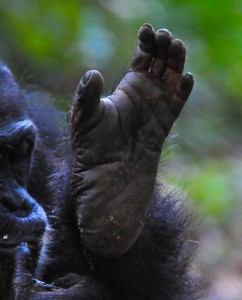 She came to Tanzania in 1957 to study zebra.┬Ā Under the stewardship of Louis Leakey, this changed and with her powers of observation, patience and daring, she arrived at Gombe in 1960 to start her work on the chimpanzees.┬Ā Leakey had hoped that he would get an ŌĆśinnocentŌĆÖ untrained observation of the chimps, and that is exactly what he got.┬Ā Here follows an abbreviated time line:
She came to Tanzania in 1957 to study zebra.┬Ā Under the stewardship of Louis Leakey, this changed and with her powers of observation, patience and daring, she arrived at Gombe in 1960 to start her work on the chimpanzees.┬Ā Leakey had hoped that he would get an ŌĆśinnocentŌĆÖ untrained observation of the chimps, and that is exactly what he got.┬Ā Here follows an abbreviated time line:
- 1960 commences work at Gombe
- Meat-eating first seen.┬Ā Tool use for termite-fishing first observed
- David Greybeard begins visiting camp, takes bananas
- 1961 Tanganyika becomes independent
- 1963 Flo in estrus brings males to the camp.┬Ā JaneŌĆÖs first National Geographic article.
- 1964 Tanganyika becomes the United Republic of Tanzania
- 1965 Jane earns her PhD (Cambridge)
- 1966 Polio epidemic kills and paralyzes chimps.
- 1968 flu epidemic kills chimps.┬Ā Gombe becomes a National Park
- 1971 ŌĆ£In the Shadow of ManŌĆØ is published and becomes a best-seller
- 1975 Tanzanians responsible for data collection
- 1977 Jane Goodall Institute founded
- 1984 ChimpanZoo founded to benefit captive Chimpanzees
- 1986 Jane publishes ŌĆśThe Chimpanzees of GombeŌĆØ
- 1991 Roots and Shoots begins in Dar es Salaam
- 1994 TACARE conservation initiative starts
- 1995 JGI Center for Primate Studies at the University of Minnesota established.
- Jane awarded the status of Commander of the British Empire (CBE)
- Jane received the National Geographic SocietyŌĆÖs Hubbard Medal for distinction in exploration, discovery and research
- 1996 Pneumonia kills one-third of Mitumba community
- 1999 Jane publishes ŌĆ£Reason for HopeŌĆØ her eighth book
- 2001 Jane receives the Ghandi/King award for Nonviolence
- 2002 UN appoints Jane as United Nations Messenger of Peace
- 2003 Re-union brings together more than 70 past researchers of Gombe
- 2004 Jane invested as a Dame of the British Empire (DBE)
- 2006 Jane awarded French Legion of Honor
- 2007 Jane Goodall Institute expands conservation work, setting up centres as far as South Africa

Visiting Gombe was a complete experience.┬Ā We had all been touched by one of the doyennes of conservation, and the staggering amount she has achieved in her lifetime.┬Ā Thanks to her vision, the legacy lives on, and for me another one of my childhood ambitions fulfilled.
Safari to the Serengeti and Surrounds
By: Nicolai and Celeste
So many mixed emotions already related to the ups-and-downs of the trailer and now the car too. Of course it is much more than just a car: part vehicle, part home and security, a form of mobile stability for our family. The high repair costs notwithstanding, we really had no choice but to have it repaired. Our choices now lay with where we wanted to stay and how best to use that enforced car-out time.┬Ā The fact that we were camped just 5 metres from the waves on a paradise-like stretch of beach did not elude us, despite our fluctuating mindset. If one has to get stranded, what better place could there be?
With a hired tractor we hauled our trailer from the so-called campsite at Sunrise Beach Hotel 2 kms down the road to Kipepeo ŌĆō meaning ŌĆśbutterflyŌĆÖ. With its camp-ground, security and chilled atmosphere we felt more at home. Calamari, chicken strips, samoosas, veggie spring rolls, beef and veggie burgers were our favourite orders in the evenings in the open-air bar-restaurant while Nicolai and Marcelo eyed-out the Euro soccer. It is hard to believe that 4 years ago we had been at the last Euro in Switzerland and Austria watching games live, visiting our friends Ilona and Denise, even going to the opera in Vienna.
ŌĆ£Is it arranged? When do we leave?ŌĆØ Danica kept asking anxiously. We had organised, after some comparisons and much consideration, to go on a camping safari Tanzania-style with a hired vehicle, a driver (John) and a cook (Dixon) whom we had met previously in Selous. For Danica, and for us, a much-talked and a dream-come-true section of the trip.
The fact that they were 3 hours late to collect us, or that the old, green Landy which made our nephew JuanŌĆÖs oldest first series model look like luxury, did not dampen our spirits. ŌĆ£WeŌĆÖre off to see the migration, the wonderful migration of SerengetiŌĆ”ŌĆØ
And now for NicolaiŌĆÖs very own ŌĆ£Dar-es-Salaam StoryŌĆØ ŌĆ”
Our car broke down about 20 km out of Dar. One of the pistons had a hole in it, even though how did we know what lied ahead of this mystery that we had to get it fixed. We went to Kipepeo where the beach is lovely, full of shells and the waves are too lovely to even speak about. While the car was getting fixed we went on Safari for two weeks.
Our first night we camped at Travellers Lodge on the green lawns at Bagamoyo, an old historical town, on the sea where Dad and I watched Portugal (3) against Denmark (2). We took a morning walk on the beach and played on the huge jungle gym, also playing piggie-in-the-middle with Mom. Then we left for the Usambara Mountains.
It took 7 hours to travel the steep and windy roads up past Lushoto to the Iringa Viewpoint campsite. The next day we went on a bird walk in the beautiful Magamba Forest Reserve for some of the specials like the African Tailor Bird, Uluguru Bush-Shrike, Slate-coloured Boubou. We also saw an orange-tipped, bushy-tailed Lushoto Mountain Squirrel (Paraxerus vexillarius) jumping in the misty trees. We left after a wonderful breakfast of cereal, fruit, omelettes and pancakes, overlooking the valley.
On our way to Arusha we went past Kilimanjaro, snow and all! Danica and I had heard so much about it from when Mom and Dad had climbed it. After we set up camp at The Maasai Camp in town, we walked to a restaurant down the way to watch France versus Ukraine on the fizzy screen. (No typo.)
After grocery shopping in Arusha we headed for Mto wa Mby (Mosquito Town). Just outside Lake Manyara National Park we saw and smelt a lot of stinky storks (Marabou and Yellow-billed) ŌĆō oooh, they smelt like penguins! In the Park we saw Silvery-cheeked Hornbills aplenty, lion in the tree and many Blue monkeys in the forest. I played soccer with John at our breakfast picnic while Dad took lots of photos of the flamingos. We saw the lovely star-shaped patterns on the tall Masaai giraffe (Giraffa camelopardalis tippelskirchi).
┬Ā
The best sightings at Tarangire National Park were the three early morning KirkŌĆÖs dik-dik (Madoqua kirkii cavendishi), Yellow-necked Spurfowl, a pack of wild dogs (rarely seen there), a pair of honey badgers, Superb Starlings, and the many relaxed elephant families surrounding the car.
Our view from the rim of Ngorogoro was of the beautiful landscape of the crater with Lake Magadi far down in the distance. The campsite at the top was freezing and there was a large herd of buffalo grazing around our tents with an Augur 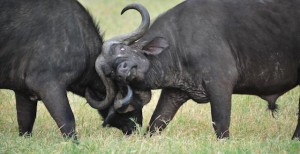 Buzzard soaring overhead. I played soccer around a gigantic Wild fig (Ficus thonningii) (CelesteŌĆÖs insert) right next to five zebra right in the swirling clouds!
Buzzard soaring overhead. I played soccer around a gigantic Wild fig (Ficus thonningii) (CelesteŌĆÖs insert) right next to five zebra right in the swirling clouds!
Caracal was our first sighting of the morning as we descended into the crater.
At the hippo pool we saw serval, tons of stripey zebra and wildebeest fighting over territory. Lions were lazing around, flamingos were feeding at Lake Magadi, kori bustards were strolling along and black rhinos raised their horns proudly. Just past the Lerai Forest area seven naughty pups pranced around their hyena parents and kept popping in and out of the den.
We enjoyed chatting to Kristin and her overlander friends over supper in the cold dining area. A Dutch lady gave us a game from the Netherlands called Flingo which Danica and all of us enjoyed in the cold, misty morning while John went to fill up with petrol but hit a cow on the way and took so long to come back.
The green changed to brown, dry ground through the Maasai land. The displays, history and talk at Oldupai (not Olduvai) Gorge were fantastic and the fact that we actually saw the cast of the famous Laetoli footprints found by Mary Leakey that were more than three million years old was amazing. Did you know that Oldupai is the Maasai word for wild sisal?
The famous Serengeti did not let us down. But why did it not let us down.
I will tell you. Spotting three lionesses kill a warthog just after entering the park – surely that is special. At the campsite we saw Miheer whom we had met at Twiga Campsite in Mosquito Town. Dad and he organised to watch Portugal play Czechoslovakia at the rangersŌĆÖ house which was no mean feat as there are no night drives at all allowed. They shouted so loud that mom even heard it, amongst the nocturnal hyenas and lions.
We travelled west (Western Corridor) to the wildebeest migration. Sadly we did not get what we wanted to see. What we wanted to see was them crossing the Grumeti River. Our second day we stayed around the Seronera area and we saw lots of things like a pair of Tawny Eagles feasting on an abandoned kill of a leopard up a tree.
Celeste continuesŌĆ”
A cheetah dashed across our path. A Leopard guarded his kill in a tree. Three zebra were rescued from deep mud at a waterhole by park rangers ŌĆō quite traumatic and emotional. The abundant lion activity was enthralling: hunting attempts aplenty; more tree climbing and finally a Topi (Damaliscus lunatus topi) kill.
The long streams of wildebeest running, snorting, grunting amidst the dust ŌĆō the sheer numbers were breathtaking. Grazed grass sheared off down low, all slanting in one direction gave us clues to the directions they had followed. So many separate lines, seemingly in disarray, certainly nothing like the neat little arrowed diagrams of explanation according to months one sees in explanatory texts. I do wonder how these particular beasts have managed so
┬Ā
well in view of their apparent lack of intelligence. What about this great natural event is so spectacular? There is an intangible mysticism to this ancient rhythm; a connectedness of beast and earth; a complete fulfilment of senses.
Lobo in the north-eatern sector was a stunning area with its granite outcrops, reminiscent of Matobos in Zimbabwe, with buffalo and lion using these vantage points as outlooks and a large hyena clan using the crevices tucked below as their den.
Danica was thrilled to come nose-to-nose with a rock hyrax whilst peeping purposefully into a crevice, careful to stay hidden from the VerreauxŌĆÖs (Black) Eagle circling overhead. The orange-leaved croton (Croton dichogamus), Sandpaper tree (Cordia monoica) and strange Stinging nettle tree (Obetia pinnatifida) stood amongst the huge boulders.┬Ā
En route to KleinŌĆÖs Gate the Acacia drepanolobiums (Whistling thorns) with their weird ant-galls were not as widespread as in Senonera but giraffe families were feeding from them, as well as from ground forbs. A pair of Defassa Waterbuck (Kobus ellipsiprymnus defassa) was a treat before exiting once more into the dry, eroded, cattle lands.
A naughty Maasai youngsterŌĆÖs stone found itŌĆÖs mark on the LandyŌĆÖs rear window. Luckily a pillow was stuffed into this back area or the human damage could have been dramatic. He and his friends fled, so Dixon, Danica and Nicolai walked 4 of his large oxen with yoke and bells to the police station at the nearest settlement while John went with the policeman to find the little fellow. Both John and Dixon are from Maasai descent and speak dialectical Maa which came in handy throughout the region. Statements took a while. Meanwhile we bought a beaded bangle from an aged Maasai lady, stooped, thin and wrinkled. The cattle would have to be claimed and paid for by his father. What would his story be that evening to his father?
Descending the Rift Valley escarpment through dramatic and dry landscape, rocks weathered and subtly hued. Lake Natron, shallow and caustic (ph 9-11), mirrored the flamingos.┬Ā The muddy shore, with sodden, grey volcanic ash was lined with the endemic white-lipped tilapia (Oreochromis alcalica) washed-up amongst bones, egg shells, feathers, hyena and eland tracks. Bat-eared foxes skulked off into the undergrowth.
We camped at Maasai Camp atop a hill overlooking both the lake and Ol Doinyo Lengai ŌĆō the Maasai Mountain of God ŌĆō an active volcano. Walking to the Ngaro Sero (meaning ŌĆśblack, clear or dappledŌĆÖ water) Waterfall through the gorge took us 16 times through the river ŌĆō stunning scenery, Euphorbia heterochroma, Euphorbia tirucalli (Milk bush), palms and white-pink flowers of the succulent Adenium obesum (Desert rose or ElephantŌĆÖs foot) ŌĆō rewarded with a swim right under in/ under / through the waterfall.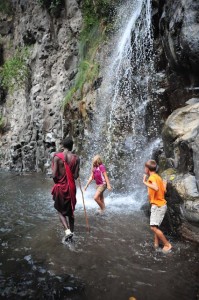
Calotropis procura (Dead Sea fruit) with their large, inflated, pods grew along the dry rivercourses through the extensive drylands. Two gates, manned by Maasai, charged high transit fees, although a new law will regulate this from July 2012. We circuited back through Mosquito Town, bypassing the Engaruka Ruins (as they are apparently overgrown and unkempt) back onto tar road all the way past Mount Meru to Moshi.
Destination: Amani- part of the Eastern Arc Mountains, a Galapagos-like biodiversity hotspot for an absolute treat. Walking in silence through the forest at sunset, strength and power and beauty mesh with spirit. We stayed in the old stationmasterŌĆÖs house at Sigi so had to drive a further 7km upwards to the research village where old German colonial buildings still house an extensive botanical and research library and a quaint post office.
There we began our guided walk with the very knowledgeable and accomplished Victor who has been there several years helping with research in the area. Magnificent tree specimens (too many to mention) were topped by the Zanthoxylum usambarense (Knobwood). After the black-and-white Angola Pied Colobus (Colobus angolensis) and Tanganyika Mountain Squirrel (Paraxerus Lucifer byatti) we were delighted with sightings of Green-headed Oriole, Banded (Green) and Amani Sunbirds, Pale Batis, Uluguru Drongo, FischerŌĆÖs Turaco, ShelleyŌĆÖs Greenbul and an African Harrier Hawk hunting. Danica was so disappointed we could not stay for a night walk to enjoy the frogs, owls and chameleons.
Asante sana (Thank you very much in kiSwahili) Dixon for all the excellent meals and red, happy mugs filled with hot tea. New tastes included corn-on-the-cob off the coals off the street corner; the largest fruit in the world ŌĆō jackfruit (Artocarpus heterophyllus); banana and potato soup and too-sweet sugarcane.
The frequent repair stops made with the Landy feel
adventurous at first, par for the course, but quickly become time-consuming and irritating. One thing is for sure, a Landy Defender can be fixed anywhere, anytime, almost with anything by anyone in Tanzania.
Nicolai closes:
When we came back to Kipepeo at 21:00 we had to sort our things out. It felt so good to be back by the sea. One more day to swim in the sea and pick up shells. Danica collected a lot of shells and labelled them all with the help of a new book on the Indian Ocean. The Dar traffic was terrible. At least we got an ice-cream while we waited for two hours in the queue for the ferry on the way back from Toyota in our very own car again.
Southern Tanzania
Selous┬ĀGame Reserve┬Āforms part of the southern Tanzanian game circuit. We had decided to stay 4 nights at Hippo camp, just outside Selous, this reduces costs dramatically.
We had travelled 3 nights to get here. 1st night out of Ibo, we wild camped outside of a town called Mueda in Northern Mocambique. To get to the famous Unity Bridge traversing the Ruvuma River took slow and patient driving for 7 hours over this infamous stretch. Tanzanian officials were warm. ŌĆ£Karibu ŌĆō you are welcome.ŌĆØ Stunning scenery and prolific 20m Tall Sterculia (Sterculia appendiculata). 2nd night we stayed in a town called Masasi, 15kms out of the town we lost our trailer wheel ŌĆō 6 nuts sheered off. Rather eerily, the wheel came bouncing past us whilst driving on a good tarmac road ŌĆō fortunately no pedestrians or donkeys hurt. We also welded the
trailer at a small village en route ŌĆō┬Ālousy job, welding machine could not get hot enough. 3rd night at Kibiti (camped outside a personŌĆÖs house as we had to wait until morning to weld the trailer). We arrived emotionally drained ŌĆō scarred. Celeste had spoken of continuing without the trailer. She felt that the trailer would not make it all the way and that we were fooling ourselves thinking it would. We travelled really slowly for 110 kms out of Kimbitti towards Selous. Being aware of every pothole and corrugation.
We identified Selous River Camp as the place we wanted to stay. The forest was beautiful but the shade meant that we would not be able to charge the tired batteries used by our freezer. Katie and Kenny were welcoming hosts, they were busy getting their camp ready for business, with them only opening the following day. Most camps in Selous close for the rainy season as the roads are impassible. They seemed extremely organized, having 2 trucks which had brought through supplies and other. We opted for Hippo Camp as they had river frontage and we could use our solar panels. In truth the road to Hippo was extremely bad and narrow, and with the trailer, we could not turn around. It was also around 16h00 by now, and we needed to setup camp and get organized. With the schlep of getting out again, we settled.
The next day was admin day ŌĆō clean out boxes. Pack away items that had not been used. Shuffle clothes around ŌĆō heading for Muslim territories, ladies needed to cover up. We were supposedly in winter too. Drill and rivet the trailer. Some Ceres fruit juices had burst in the heat and together with the tins ŌĆō corroded and messed, lots. Freezer was not working ŌĆō the wire used to override the thermostat had shaken free, replace and adjust. Nicolai and Danica made breakfast of bacon, sausages (we had to use up some of our now de-frosted meat) and our last 4 eggs. We got washing done. Re-charged camera and assorted batteries. The children were rewarded with a game each for the PSP, they had been doing really well. Packed away completed school/exercise books. We had a late lunch/early supper ŌĆō chicken Korma and went on a split time boating safari on the Rifiji River. 1,5 hours today and 1,5 some other time.
The next morning I was up before sunrise. To me this is the most beautiful time of the day. I had a plunger of strong coffee, in a half meditative state, I was ready to meet the day. An African skimmer, rippled the surface of the Rifiji river as the day started to appear. Ground Hornbills were calling, far away. Behind me, there were Greater Galagos saying goodbye as they completed their nocturnal escapades, being replaced by the diurnal Samangos, the shaking of branches revealing their presence.
WeŌĆÖre now about half way into the trip, has it been a success? Well, what is a success? Have we helped save any rhino? As with most trips and accomplishments, one does not see it when youŌĆÖre in it. It is only afterwards upon reflection that one appreciates the merits and efforts, the joys and awakenings. Well perhaps this is one such morning. The pinkish hue over the river revealed Trumpeter Hornbill, 36 of them groaning as they flew in a southerly direction across the river. Why they were all together I was unsure, but a large flock for this species I thought? A lone Openbill, prodding the shore of the island I looked onto, was joined by a White Crowned plover that started to protest, loudly, probably anxious that he was still alone. Behind me Collared Palm Thrush was calling, another beautiful day in Tanzania.
The children had been doing well. It was an honour to witness Nicolai taking on his first book ŌĆō ŌĆśShock for the Secret SevenŌĆÖ. Every 10 minutes weŌĆÖd get an update ŌĆō Jack had left the group and now they were the Secret Six. ŌĆ£ IŌĆÖm on chapter 5 now dadŌĆ” another sheep dog has disappeared now dadŌĆØ and so the reports continued. I encouraged him, with reading not being a strong point of his before we left, he had really made good progress on the trip. He had also read out aloud to us 4 stories of Horrid Henry so far. It was a wonderful privilege to see him growing visibly in front of our eyes.
Another 7 Crowned Plovers had arrived on the island and a flock of geese from Egypt. Danica was up and went to have a look at the Samangos. Yesterday we were in the main Selous reserve (you donŌĆÖt pay park fees when you camp outside the park, eg Hippo camp). They unashamedly had charged us 220USD ŌĆō 65 per adult and 45 per child. Vehicle entrance fee was 50 000 Tanzanian Shillings. I felt that this was prohibitively expensive. The roads in the reserve were crappy. The reserve itself was truly superb. Even though we were effectively only scratching the surface of the worldŌĆÖs largest game park, the different vegetation types and landscapes we encountered were wonderful. There is the river ecosystem with the life it supports. Hippo spot most of the inlets, on the banks a variety of palms, traveler and other. The Savannahs seem healthy, with the implala, zebra, wildebeest in prime condition. Giraffe are common and with their strange gait and different pattern to down south, always a pleasure to see. We made our way to the grave of Selous.
He died in 1917, shot by a sniper in the war. I thanked him for his efforts in setting up this beautiful reserve. Although principally a hunter, and conserving for the sake of having more permanent hunting grounds stocked with animals, his role had been taken over by German government. They have since 1997 been the driving force for the modern day game park that Selous now is. They have set up a revenue split with government where essentially 50% stays in conservation of the park. The rest goes into the chasm of uncertainty. In a way, this soothed the pain of high fees that we had paid at the entrance gate. Celeste noted that there were 7 entries into the visitors book yesterday ŌĆō 7 different groups that had come through. This was not much I thought, however it was early June, and the park had effectively only just started with its busy time of the year. We got back late ŌĆō 7 minutes past our curfew of 18h30. We had a busy day of tracking ŌĆō DanicaŌĆÖs favourite, exploring, observing, absorbing as much as we could for 220 USD. We had seen the tracks of female leopard, lion, eland, elephant, hippo
, giraffe and stacks of others. Our sightings were less spectacular as regards the mammals. We missed out on a pride of 7 lionesses and did not see one elephant. A hyaena greeted us at the gate, just off the air strip, as did a gate attendant eventually. Arriving at an unattended gate, Celeste got out to open and a gruff attendant closed the gate she had
opened and told us to wait. I had often found that when there was little English spoken, people came across as being rude, which may not necessarily be their intention. Said attendant was joined by a Tanzanian wildlife official and asked why we were late (all 7 minutes of it). I diverted the question by saying that the roads were really bad in this beautiful park belonging to the people of Tanzanian. However all was good with us talking about rhino and the work being done at Rhino Rescue Project. He mentioned that they had, according to the census last year, 50 black rhino. This was disappointing as the guide book mentioned 150. Someone was wrong?
Ibo Island ŌĆō Mozambique
By: Celeste and Danica
ŌĆ£Beware of the ŌĆśIbosonsŌĆÖŌĆ”.they love to sneak away every shoe they find and take them up to the treesŌĆ” – be warned,ŌĆØ teases Marcelo. Islands tend to evoke images of sun, sea, sand, sunsets ŌĆ”. Ibo is all this and more. ItŌĆÖs inaccessibility only adds to itŌĆÖs romance. It only took us a few hours from Pemba (6 hours by road and 1 hour by wooden dhow). The Yemenese architect, Marco, made our passage more interesting with his world knowledge and international lifestyle. One of the largest islands in the Querimbas Archipelago,
Ibo also boasts a long and somewhat clandestine history of Arab, Chinese and Portuguese trade, with slavery and corruption continuing into the recent era in the form of horrific incarceration and deaths of political prisoners in one of the three forts ŌĆō reminiscent of South AfricaŌĆÖs Robben Island.
┬ĀA definite highlight is the cultural and historical tour of the island where we walked in these memories sitting heavy on the land and historical buildings. The entire island has been
nominated as a World Heritage Site and, as such, when re-building, each structure has to be true to itŌĆÖs original architectural style.
Many of the buildings were constructed from lime and coral-stone with the lime white-washing fading into characteristic cream and pinkish patches. Ibo Island Lodge has also kept itŌĆÖs original thick and not necessarily straight walls. From the open rooftop bar and dining area we enjoyed the peaceful sunsets and home-made snacks served on blue glass dishes. Like the ancient Egyptians and Greeks, we revelled in the prolific stars, our gazing efforts guided by the accomplished and fittingly-named Cosmo.
Dinners were sumptuous affairs with appetizers; soup and bread rolls; sorbet; main and pudding. Whimbrels and crab plovers called in the muddy flats, punctuated by mangroves, dark against the soft moonlighted ripples. As befits royalty, we retired to our suites, complete with oversized four-poster beds (and bedtime biscuits), over-sized wardrobes, mirrors, sea-blue-green curtains and a view of the ocean from the (you guessed it) over-sized shower. Some might say the style was shabby-chic but after camping for so long, it was definitively elegant! ŌĆ£What time would you like your tea/coffee tray served on your veranda?ŌĆØ Lily, a
travel expert from the U.K. was a delightful companion out on the dhow to the tiny island, only visible at low-tide. This was where we enjoyed a luncheon with Nic and Sarah, from the U.K. too. Thank you for joining us for dinner, Lizzy, and for delighting the children with your tales of travels and sorest sores. Danica was absolutely spell-bound with her very own guided undersea snorkelling adventure, holding CosmoŌĆÖs hand and taking her own photographsŌĆ” She tells more: ŌĆ£It was a very strange coral reef with short, stout columns scattered all-over. There weren`t many proper corals (it was mostly sea-grass and soft corals) but a great variety and abundance of fish including some
I had never seen before like the crowned squirrelfish, dusky sweepers, sea goldies, blue-barred parrot-fish, blue pullers, a clown coris, two tone chromasses, checkerboard, gold-bar and crescent tail wrasses. Other fish I had seen were domino fish, blue-streaked cleaner-wrasses, two-bar anemone fish, masked coachman and thread-fin butterfly-fish. My all-time favourite was the 40cm blue starfish (Linckia laevigata). This incredible feeling of joy is surely what the dolphins experience as they leap out of the water. By the way, we saw two pods of humpback dolphins, too!ŌĆØ Rob (ex S.A.), the manager, and his wife, Glyn, are excellent hosts (with Ibo the lovely ridgeback) and continue in the tradition of the Ibo Island Lodge of uplifting the local population of 4500-6000 inhabitants by providing funding for schooling and guide training as well as running a Montessori Nursery School. A small world: we found several people we know in common, including Wapnik, from Sani-to-Sea fame and RobŌĆÖs cousin who designed the ŌĆśSave the Rhino red-and-black beaded braceletsŌĆÖ sold throughout the South African National Parks.ŌĆÖ
Danica and I were treated by Dad to a little something in the jewellery line from the local silversmiths ŌĆō delicately crafted and very special indeed ŌĆō and demonstrated in tiny fired forges by father-and-sons. The game of ŌĆśwhat was your best?ŌĆÖ which we play regularly was tough to answer. Marcelo, of course, came up with the brightest reply: ŌĆ£The fact that the ŌĆśIbosonsŌĆÖ did not steal my shoes.ŌĆØ
Pemba ŌĆō Mozambique
By: Celeste
It was a looong 3-day haul to traverse the width of Northern Mozambique from the Malawian border to the East coast on the Indian Ocean: sleeping in places best forgotten; welding (again!) the trailer and repairs to the leaf springs from 06h00 to 16h00; wonderful scenery amidst huge rocky outcrops and lush riverbanks. ŌĆ£I am glad Daddy can practice his Portuguese again,ŌĆØ says Nicolai enthusiastically. He is quite right. It smooths the way, every step of the way.
The town of Pemba is typically African: sprawling across hills with beautiful sea views down to the poorest shacks and unkempt roads. It is bustling with activity and trade in shoes, t-shirts, you-name-it. The barber trade is strong. Some buildings have been restored around the harbour area, sharply contrasting with those that remain in ruins. A soccer pitch is busy with players next to the
Catholic Church. There is a large high school and a Christian University. We enjoyed an espresso with natas, purchased some fresh bread from the pastelaria and a very small basket of goods from an Indian grocery store with exorbitant prices. At Pemba Dive and Bush Camp we were welcomed at the large lounge and bar area with a murky, oxide-coloured and textured fruit juice, rich in anti-oxidants and Vitamin C. ŌĆ£Any guesses?ŌĆØ asks Lyn. ŌĆ£Baobab,ŌĆØ I reply without hesitation. She is surprised but we had just had a baobab and chilli jam in Malawi. We settled in, enjoying the setting ŌĆō white beach amongst the mangroves. There is a large difference between high and low tides with each having its own mood. Fiddler crabs emit sharp clicks and waggle their over-sized pincer around threateningly. Danica and I explore the beach and mud flats for hours, admiring the muscle shells growing on the mangrove trunks, the dogfish, a washed-up, White-spotted Puffer fish and especially the tiny, white anenomes she discovered on the underside of a log. Nightly crab, bat and Galago (bushbaby) hunting is a given. ŌĆ£Fiddler crabs, look, Mom, Dad!ŌĆØ was the 6am NicolaiŌĆÖs wake-up call.
The kids are free to roam and revel in this freedom. Days take on their own form: schoolwork, diaries, planning for the next few days and longer and the daily chores: washing clothes, cooking, washing up, cleaning, preparing bottles for the day with water and juice and water sterilisation drops ŌĆō either silver chloride drops or purifying tablets. Our kids never had baby bottles but I now have a feel for it. We partake of all the activities on offer, all inclusive at the camp: kayaking in a triple with the children and going on a long nature walk with Kai, learning about white, black and red mangroves and the different ŌĆślevelsŌĆÖ of mangroves as one moves inland from the sea, as well as a myriad of local folklore and culminating inside a venerable 3000 year-old baobab, once a refugee hide-out, and still standing as a symbol of strength and vitality.
He is a BFG (Big Friendly Giant) who loves to share his knowledge of the area and play with the kids, sharing some new Dexter tricks with Nicolai on his PSP and also teaching us the original (?) nine-spotted domino game. He is shadowed 24/7 by his large Great Dane, Duke. Kind of like how Disney portrays dogs and their owners being similar in ŌĆś101 Dalmations.ŌĆÖ On our last evening we share a lobster dinner at the beach area with fellow travellers: Frans and Beatrice from Switzerland. He is in construction and she is an O.T. specialising in dysphagia (swallowing problems) ŌĆō quite a co-incidence. That last morning he helped Marcelo repair the ŌĆśrunning boardŌĆÖ and main section of the trailer which had separated from the nose-cone. Over coffee, Marcelo shares all our Zambian travel info with them. They decide to get to Tanzania and then return southwards again, not to have to worry about the more unstable countries up north. Another Romanian couple on a motorbike were really travelling light, just their tent and buying food day-by-day. They had already travelled for 11 months coming down From Europe along the West and South coast of Africa with not even one safety incident ŌĆō hardly surprising considering her effusive, shining, positive nature.
┬Ā
But our highlight of Pemba is undoubtedly the magnificently muddy mud bath ŌĆō hair and head to toes ŌĆō squishy and gooey, filled with essential mangrove goodness to re-vitalise our hair and skins. Of course, the flinging fun of it all was absolutely carefree and youthful! Much ŌĆśbettererŌĆÖ than being stuck in the mud any time.
┬Ā
Liwonde National Park
The premier wildlife park in Malawi seldom disappoints.┬Ā With the Shire River running through the park, there seems to be enough for all.┬Ā Poaching appears to be under ŌĆścontrolŌĆÖ and with an absence of large lion populations (only one individual male sighted regularly) violence does not seem to be part of this National Park.
As a result, the ungulates are chilled.┬Ā The waterbuck are large and plentiful. Sable are doing really well too, with a population of 1200 odd.┬Ā There are a lot of Mopanes, however as Celeste commented,ŌĆØ ŌĆ”these are probably the most beautiful Mopanes I have ever seenŌĆØ.┬Ā Being in the park in May was the beginning of the dry season, which made a change, as 12 years ago we visited in the wet season, and could not get 3kms from the entrance gate as the roads were awash with water and run-off.┬Ā These days there is a ferry to Mvuu camp in the north so no worries about timing visits.
An early morning drive yielded Spur-winged Plover.┬Ā This was a pleasant surprise considering they are not meant to occur in Malawi, at all.┬Ā There is a platform on a tributary just off the Shire which is a very peaceful place and worth a few stops.┬Ā We were chuffed to see Grey-headed Parrot, Lizard Buzzard, Osprey and Boehms Bee-eater aplenty.┬Ā There was a small party of 12 elephant enjoying the waters of the Shire too.┬Ā It was a treat to see HildebrandŌĆÖs Francolin on the way back.
Lillians Lovebirds are commonly heard in the park, but can be difficult to see.┬Ā Their small size combined with the fact that they enjoy the tops of trees makes it awkward.┬Ā They also have brilliant camouflage with the bright Mopane leaves.┬Ā There is currently a study to evaluate the effect of various environmental factors on their numbers.
I decided to treat myself the following morning, and go rhino tracking.┬Ā This was offered for 40usd, expected to take about 3 hours and included breakfast.┬Ā I was up at 04h30 and was joined by Christopher the tracker, Maxwell, the gun bearer.┬Ā Julius was the official guide, and Frank was a German guide in training.┬Ā We searched for hours, prints, middens, resting places of black rhino, but no visual sightings.┬Ā We had taken 05h00 hours and no joy.┬Ā We did get some super sightings of LivingstoneŌĆÖs Flycatcher.┬Ā We also saw some fresh, clear prints of lion too.┬Ā
Nothing like the smell of steaming fresh elephant dung (they break in and out of the sanctuary from time to time).
The highlight of the day was meeting Michael Labuschagne.┬Ā Michael is responsible for and has achieved tremendous success with the Liwonde scouts conserving the game. This morning he was running a coxswain course for the scouts, which is critical for patrolling the Shire River.┬Ā We had already seen numerous poachers ŌĆō mainly wood, but Mike had mentioned that they do come over the Shire to poach Waterbuck and other game.
Speaking Rhino Rescue Project (RRP), we shared information regarding rhino conservation and the successes and failures of folk in the neighbouring states.┬Ā Michael mentioned that some of the successes that he had achieved, were through partnerships such as engineering for the roads and an IT specialist to help with computer education.┬Ā We spoke about the RRP partnering Liwonde in their conservation plight as well as possibly training some of their trackers and guides by some FGASA field guides.┬Ā In travelling around the park, we noticed that the villages were increasingly close to Liwonde and this was causing pressure on the local wildlife.┬Ā I felt that the rhino population was a ticking time bomb, with poaching of rhino and demand on horn as it is presently.
Urgent Appeal
Michael made it clear that although he was keen on the benefits of RRP, they were light years away from being able to afford such luxury.┬Ā The only possibility is if we could somehow raise the funds for them.
12 years ago, when I first visited, they had then recently started their rhino breeding program receiving rhino from SA ŌĆō 6 in total. Today in 2012, they have increased that number to 18, essentially tripling what they received.
Malawi today has just had their first lady prime minister in power, Joyce Banda.┬Ā Although the country is filled with optimism, it is reeling from the tyrannical reign of Mutharika (who died suddenly this year of ill health).┬Ā The country was led poorly, and as a result has had huge forex and fuel shortages. ┬ĀWith Joyce Banda, this is starting to right itself.┬Ā However, in scenarios such as these, we have often seen that the wildlife suffers.┬Ā Recently, Liwonde National Park received just 400usd to run operations in the park for a month.┬Ā This is clearly inadequate for a park of 548km2.
There is a sectioned off area of the park where the rhino are kept.┬Ā This controlled area has a few issues:
- It was established with the idea of breeding the rhino to a point where the rhino population had been stabilized, and then to drop the fences and release the rhino. ┬Ā
- The area has become too small.┬Ā Having lost one male bull to fighting, two other younger bulls were released outside the enclosure.
- The fence is in a state of disrepair and can no longer be electrified.
- Breeding is being hampered in the cordoned off area, as the area is too small.┬Ā The dominant male is consistently attacking other males.
- The time to expand and release the rhino into the rest of the park is now.
As well as Liwonde, Malawi also has Majete Wildlife Reserve.┬Ā This is 700km2, and although it is not as well established as Liwonde, has a population of 6 black rhino (2 from the breeding program at Liwonde).
Mike Labuschagne is responsible for writing and revising the ŌĆśRhino PolicyŌĆÖ document for Malawi.┬ĀAs mentioned in the blog above, he is currently stationed at Liwonde and in charge of the rhino conservation efforts as well as anti-poaching.┬Ā It is also great that he is seriously opposed to de-horning.┬Ā We discussed in length the benefits of the Rhino Rescue Project and the efficacy of using the ectoparasiticide treatment at Liwonde.┬Ā He is extremely keen, and is prepared to have the RRP integrated into the national Rhino Policy manual such that statement such as ŌĆ£all rhino occurring in Malawi will be treated with prescribed ectoparasiticideŌĆØ. ┬ĀAs a country they could boast that ALL their horns are treated – therefore poachers stay away!
The problem is that they have no funding.
Treatment costs 2000 usd per animal and we urgently need to raise funds for this cause.┬Ā Should you be willing to make a contribution to this cause, please access the bank account through the ŌĆśDonationsŌĆÖ section of this web page.
Zomba Plateau
Fuel shortages in Malawi had vastly reduced our travel plans in Malawi.┬Ā We focused instead on the south of the country as we were to pass into northern Mocambique.┬Ā We had hoped to take in Vwaza marsh and Nyika, however with the revised plans, we went in search of some specials and altitude around Zomba Plateau.┬Ā It was the weekend and found that the campsite at Chitinji had closed down.┬Ā There are numerous locals around that are desperately looking to provide a service in return for a fee of sorts.┬Ā We met Michael who suggested that we consider a cottage.┬Ā As it was getting late and we knew the plateau could get cold at 2087 metres, we decided this could be a wise option.┬Ā We found Guinea Fowl Cottage, which at a price of 40 usd per night, came with Edward the cook and two other assistants, on a lavish Houghton style garden.┬Ā It was a treat to have a fireplace lit at night, all meals prepared and regular trays of tea for Celeste.
The supply of fresh, ripe fruit was suddenly abundant; raspberries, strawberries, gooseberries, red bananas, a treat.┬Ā Being close to 70, Edward had seen numerous changes in Malawi in his time, and he was upbeat and optimistic that Joyce Banda (newly inaugurated president) would put Malawi back on the straight and narrow.┬Ā In fact whilst we were in Malawi, we ourselves had no problem with fuel and saw that things were improving almost daily.
Zomba has over the years had dignitaries gracing her circular route. Haile SelassieŌĆÖs visit gave the name to EmperorŌĆÖs view and the Queen Mother visited the plateau in the 1950s providing the QueenŌĆÖs viewpoint.┬Ā One of the oddities is ChingweŌĆÖs hole, only 8m in diameter, but at 60m deep, some claim it reaches the base of the Rift Valley.┬Ā There is a tradition that chiefs in the old days threw their enemies into ŌĆśbottomlessŌĆÖ ChingweŌĆÖs Hole, and there is rumour that BandaŌĆÖs regime revived this tradition.┬Ā
The view from the rim of the hole is the most spectacular in my opinion of the plateau.┬Ā Perhaps this would be a good place to throw all rhino poachers?
The Next Crossing
┬ĀAnother border day ahead with all its unknowns and opportunities. Swapping SA beaded flags and Aussie koala bears and pencils, we bid farewell to Nic and Zulfaa, braving the rutted road ahead with some trepidation. Back at Chipata we re-fuelled and yes, you guessed it, had the trailer re-welded at GolfŌĆÖs repair shop. He was a very pleasant elderly gentleman, well-spoken and his large yard was full of cars in various states of undress. A rounded man in a red t-shirt sauntered in wanting to know how we could do all these changes (roof-rack, bull-bar, etc.) to our vehicle which was ŌĆśfor ministersŌĆÖ. He said he worked at the office of the president but did not know what the new Zambian monetary notes would look like.
┬ĀWe got only a few groceries at Spar as the prices were steep. A small container of plums was R60-00. Sorry Nicolai, we cannot get your ŌĆśfavouritistŌĆÖ fruit. Two young ladies with a cheeky sense of humour at the in-house coffee shop boasted that they had the best coffee in all the area and only this morning they had in a pompous minister ŌĆō their words, not mine. Could it have been the red-shirt?
┬ĀThe easiest border crossing ever! Stamp, hand in TIP and voila. Chipata is now a 24 hour post and just as easy on entry into Malawi, signing the Carnet de Passage without fuss.
┬ĀCareful of changing ŌĆō as ever.
┬ĀOne very good tar road to Llilongwe, with lots of up-and-coming buildings and a new shopping centre with familiar SA brands: Spar, Game, Foschini. There were many petrol stations along the way ŌĆō no fuel in any of them as we had heard. Except one with very long queues ŌĆō waiting for an imminent re-fill perhaps. We had had to re-design our whole itinerary to Malawi due to the fuel shortage. Luckily it is a long, narrow country so by restricting ourselves to the South, we could rely on fuel at the border posts if needed. I do hope the new president will bring some good changes to this wonderful country ŌĆō and soon!
┬ĀIt was 8pm and we had already been through 8 roadblocks ŌĆō all friendly and smiling, wearing impressive, new, shiny (important at night) jackets and uniforms. ŌĆ£Where are you coming from? Where are you going to?ŌĆØ No more questions, no papers or inspections. At one stop we were told it was customary for a tourist to give the police a Fanta ŌĆō and so we did. Laughing, sort of, Marcelo questioned, ŌĆ£Is this not a bribe?ŌĆØ ŌĆ£No, no, it is not,ŌĆØ they laughed.
We turned, thanks to Charlie (our GPS lady), onto a sand road without a sign. A sharp tap on my window drew us to a halt. ŌĆ£Not this way, the next road.ŌĆØ We continued a few kilometres and indeed there was a tar, sign-posted road to Monkey Bay. Thank you, Angel!
┬ĀA winding descent into the valley, slowly ŌĆō would have been a great view if it were not dark. A beautiful road into the Cape Maclear Nature area rewarded us with a black-and-white fluffy POLECAT ŌĆō wonderful! We squeezed Staffie in between village houses, all asleep until we were welcomed at the gate: Fat Monkeys.
Lake Malawi
┬ĀA beautiful lakeshore, spectacular sunrises and sunsets, relaxed atmosphere. We really needed this after the last few tough days of travelling long hours and trailer repairs. We had breakfast at the restaurant/ bar ŌĆō all these are thatch and wide open with that island feeling: pancakes with honey for Danica; vegetable omelette for me; full house for Nicolai and pancakes with bacon┬Āfor Marcelo. The hand-crafted wooden tray is laid on the table with the widest assortment of condiments I have ever seen!
┬ĀTo the side of each lodge is an area for the craftsmen and their wares together with the tour guides: bracelets, necklaces, little boats, bicycles, paintings, cloths and ŌĆśHappy PantsŌĆÖ which are certainly very cheerful. The children made their own purchases for their friends. We ordered some keyrings to be hand-crafted with names on and rhinos from Fountain (it is his name, really!). Later, we succumbed to purchasing a wooden game of Bowa or Boa. Apparently there is a male and a female game which was taught to the children and me at
Gecko Lounge by the barman. We went there as we had heard their pizzas were excellent ŌĆō which they were but they had tripled in price and then some since our guide book was published (April 2010). Nicolai has been the reigning champion ever since!
Peter, our tour guide took us by boat along the shore, showing us all the lodges towards OtterŌĆÖs Point before we headed out towards Thumbi Island. He slipped some bread overboard as we rounded Mitande Point and the cichlid show was on.
Colours and flashes of delight as we and the cichlids intermingled, sucking on our toes. Nicolai was remarkably confident in the clear, cool water, knowing there were no sharks or sea urchins or stinging bluebottles about! It was like being part of a magical netherworld. Danica, of course, was in her element, taking underwater photos and pointing and gazing to her hearts content. The sign painted on the large rocks: Welcome to Lake Malawi National Park. Do not toilet here ŌĆō with an explicit depiction of a person doing just that ŌĆō and a cross right through it. This was where we sat and enjoyed a snack, sharing with the large, striped island lizards.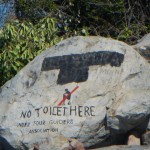

We rounded the west of Thumbi to see the fish eagles ŌĆō about twenty resident, breeding pairs. Peter whistled, calling ŌĆ£CheriŌĆØ, before throwing in a small fish. ŌĆ£Mark that point,ŌĆØ he instructed, and we did ŌĆō rewarded with huge talons and a dramatic fly-by, trophy clutched tight.
 It is so rewarding to see the children growing day-by-day, just blossoming. Nicolai swimming out to the old boat anchored about 30m off-shore by himself and Danica being able to greet and chat and share with others. She formed a special relationship with neighbouring campers. A lady in every sense of the word, Carol, too, took to Danica and they looked at all her photos together, sharing wild and daring camping, wildlife and travelling stories. The children were enraptured by her tales of paragliding in Turkey, micro-lighting over the Victoria Falls, swimming wild and free every morning at her home overlooking the Hermanus Lagoon. ŌĆ£Mommy, Carol is just wonderful. I am so inspired by her!ŌĆØ Danica whispered to me at bed-time. Thank you Carol for your interaction with our daughter and for sharing her wonderment of the world!
It is so rewarding to see the children growing day-by-day, just blossoming. Nicolai swimming out to the old boat anchored about 30m off-shore by himself and Danica being able to greet and chat and share with others. She formed a special relationship with neighbouring campers. A lady in every sense of the word, Carol, too, took to Danica and they looked at all her photos together, sharing wild and daring camping, wildlife and travelling stories. The children were enraptured by her tales of paragliding in Turkey, micro-lighting over the Victoria Falls, swimming wild and free every morning at her home overlooking the Hermanus Lagoon. ŌĆ£Mommy, Carol is just wonderful. I am so inspired by her!ŌĆØ Danica whispered to me at bed-time. Thank you Carol for your interaction with our daughter and for sharing her wonderment of the world!
┬ĀFrikkie, a sheep farmer from De Aar, it was a pleasure making your acquaintance and many thanks for helping out with StaffieŌĆÖs batteries. May all your inspirational life and business plans come to fruition!
┬ĀWe met so many people here: Kristina, Herik, Moa and Oskar from Sweden, plucking a guitar gypsy-style; Des and Brenda Quin from Natal; Neill and Julie Bird from U.K. ŌĆō each travelling and fulfilling their own dreams. Bon voyage to you all.
Walking on the inside Chembe village track passing babies sleeping on laps; men repairing nets; fish drying on racks; children playing a jumping game. We bypassed a ragged cemetery ŌĆō the second in the immediate area – the other being known as ŌĆ£Mission GravesŌĆØ 1km inland from LivingstoneŌĆÖs original mission established in 1875 but abandoned and relocated in 1896 due to the high incidence of malaria. Yes, we do still take our daily muti and the kids gulp down their yucky ŌĆśFridayŌĆÖ muti.
┬ĀEnjoying DanicaŌĆÖs photos around the fire, it is not difficult to see why Lake Malawi National Park was inscribed as a UNESCO World Heritage Site in 1980. Set aside for its unique diversity of fish, the evolutionary significance of which has been compared to the finches of the Galapagos.
┬Ā The lakeshore, regardless of this status, is used for washing bodies, dishes and clothes, with leftover corn cobs washing up with toothpaste tubes and glass shards. Fishing boats go out within the designated borders. ŌĆ£Yes, they are not allowed,ŌĆØ said Peter, ŌĆ£but it is Sunday and all the officials at church.ŌĆØ Nightly fishing is an age-old tradition here, with small Usipa fish being attracted by the mokoroŌĆÖs lanterns.
The lakeshore, regardless of this status, is used for washing bodies, dishes and clothes, with leftover corn cobs washing up with toothpaste tubes and glass shards. Fishing boats go out within the designated borders. ŌĆ£Yes, they are not allowed,ŌĆØ said Peter, ŌĆ£but it is Sunday and all the officials at church.ŌĆØ Nightly fishing is an age-old tradition here, with small Usipa fish being attracted by the mokoroŌĆÖs lanterns.
┬ĀThe play of light upon the water is certainly inspirational. Cormorants dive and bob, spreading out their wings, sun-worshipping. She rises magnificently, scoring the wave tops with light and colour, bringing energy and a peace embued with vibrance, till setting behind the island quietly slipping away, withdrawing her soft dusk touches. A daily blessing of the Nankumba Peninsula, of everywhere on Earth.┬Ā┬Ā┬Ā┬Ā
South Luangwa National Park
By: Celeste
Lusaka along the Great East Road about eight hours to Chipata into the Great Rift Valley ŌĆō doesnŌĆÖt that sound great? The South Luangwa Park is world renowned for its wildlife. Our visit here so many years ago is dominated by two very distinct memories: roads too wet to travel on and hippos surfacing like primeval beasts out of crescent-shaped oxbow lakes, green swampy vegetation adornments spread over their massive heads and backs. Nothing like it for a skin treatment.
We camped overnight at Mama RulaŌĆÖs with the children thoroughly enjoying playing with the five (or more) dogs and Jack Russell puppies.
Danica was particularly excited to explore Luangwa after reading about it in the non-fictional book entitled ŌĆ£BuluŌĆØ (also a Jack Russel), also describing the establishment of the Chipembele Wildlife Educational Centre by the authors Steve and Ann Tolan.
We headed for the Park along a winding tar road, cyclists carrying seemingly impossible loads: fruit and vegetables stacked up in woven baskets; hay bundles; buckets in candy colours twenty at a time forming a three-metre tall hat! And then the road ran out, down to a horrid, rutted, potholed track weaving alongside the roadworks. We crawled, aiming for the Moondog Caf├® alongside the Mfuwe Airport, which, according to the guidebook had a large information board about all the accommodation options in the area.
Not. No Moondog, but there was a caf├®. But even the cappuccinos tasted sour with the news that the trailerŌĆÖs chassis had cracked through again – so the whole process was started again. We were very lucky this time to have the tri-party all fairly close at hand ŌĆō welder, welding machine and power. Meet and greet more locals, chatting about the merits of bicycle up-grades and having cool drinks that even Marcelo (the least fussy) could not down! Hanging from an old, crumbling wall in the trees nearby (only found when doing you know what in the bushes) was an animal skin. One local sitting on a log was
casually teased by some of the welding clan ŌĆō always a group ŌĆō that he was a poacher. Laughter and head-shaking was not a convincing denial. Next door was the equivalent of a miller, I guess. The place where the locals bring their sacks of maize to be weighed and crushed ŌĆō the workers absolutely covered in fine powder ŌĆō white even on their eyelashes.
The trailer was bombarded with re-bars welded on with eyes shut ŌĆō no welding mask. A tar road between the airport and the surrounding game management area of the park was more pothole than tar and singe-lane narrow. Flatdogs Camp no longer offered camping but we settled in comfortably on the Luangwa riverbank at Crocodile Camp, huge pods of huge hippos spread out below, elephants and buck drinking from the opposite bank. Power (erratic), thatched lapa with wooden table and benches, white tree frogs, an unidentified snake under the washing line (dangerous business this) ŌĆ” what more could one ask for?
More close encounters. At 23h00 I was awakened by the sound of rumbling pachyderms, close by. A large male was exploring our vehicle only 3m from us. Trunk uplifted he found nothing to interest him in the black ammo boxes on the roof rack. Trunk tip still raised, he lowered the bulk to the rear left window and pressed. It must have been only a gentle push otherwise he would have got to the watermelon inside if he had really wanted to, I am sure. Meanwhile, his tusks had been scratching the side panel all around the diesel tank. Luckily it was not pierced. Danica must have sensed the danger, sitting bolt upright in her bunk. I whispered for her to be absolutely still and quiet. Obediently, she lay back down and promptly went back to sleep. The rotund rascal then soft-footed it around Nic and ZulfaaŌĆÖs ground tent, popping open a sealed rubbish bin and breaking a few branches. After he had left, we all met out under the stars, a wee bit shaken.┬Ā┬Ā
The young couple are from Sydney and have been working and wending their way across
Africa since the Soccer World Cup, planning to end their journey in September 2014 with their wedding in Greece. Full of fun, Nic, a chiropractor, played rugby and Frisbee with the kids and swam in the strangely-shaped pool. Knowing it used to be a crocodile farm made it feel a bit weird. We shared some meals with them and on our second day in the park we travelled in convoy, joined by a two-way radio. Early that morning we sighted a female leopard jostling with her two cubs ŌĆō wow!
We were fortunate to see all three of the mammal specials: the Crawshay`s zebras (Equus burchelli crawshaii) lacking the shadow stripes; the beautiful ThornicroftŌĆÖs giraffe (Giraffa camelopardalis thornicroftii) and a lone CooksonŌĆÖs wildebeest (Connochaetes taurinus cooksonii) on LionŌĆÖs Plain. And thatŌĆÖs not all. On the leaf litter deep in the swamp in the thick riverine vegetation was ŌĆ”ŌĆ”ŌĆ”.
PELŌĆÖS !!!
Expectation, excitement, full of emotion, I awoke.┬Ā Today was going to be a big birding day┬Ā5 lifers maybe.┬Ā I hummed contentedly to myself, the sun had not yet risen as I put on my summery sandals.┬Ā Some early morning coffee, and then IŌĆÖd be off.┬Ā There was a bit of a breeze I noticed, oh well, nothing that a few warm rays of sunshine would not brighten up.
There were three feint stars left, and the rosy hue of sunrise was starting to show as the strong coffee was well received.┬Ā There was a chill in the air surprising I thought for a location 12 degrees south of the equator.┬Ā The family were snug, warm in the tent, not thinking of getting up yet.
It had been a slog to get to Mutinondo.┬Ā 20000 kilometres, having not taken the most direct route, sheared chassis’ of trailers, but this was the locale of our Miombo birding hotspot.┬Ā The place where we were going to see AnchietaŌĆÖs Barbet, Lead Coloured flycatcher and their friends.┬Ā The breeze, now a wind, had picked up.┬Ā Cloud cover had moved in, disturbing the rising of the sun, the birds were not calling.┬Ā The script was unraveling at a horrible rate, there was no time for re-takes, I had to focus.
The site that we had picked for our camp looked over some beautiful whale backs.┬Ā These granitic masterpieces had risen from the earthŌĆÖs crust millions of years ago, and separate the different valleys in the region.┬Ā Some of them were hollow as you walked over them, almost giving off a basal drumbeat with each step.┬Ā Beautifully odd.┬Ā
The high-pitched, creaky, metallic sound of a sunbird, awesome, Miombo Double-collared, not a lifer, but nice to see in the area.┬Ā Bulbuls, Turtle doves, starting to chatter, maybe the script will get back on track.
Climbing the whalebacks gets the circulation going and the view is really spectacular.┬Ā In the valley below, the sounds that characterize a river falling hard over unforgiving rock, filters through the brachystegia and julbenardia.┬Ā Perhaps a stroll down the valley would provide more birds.┬Ā I suppose I should hold myself responsible for pitching up in May in Miombo, for the
quietness.┬Ā However, these birds are resident, they must be around?┬Ā There are fruits around and we even saw some flowering proteas (Protea angolencis) coming in yesterday.
The river is darkly coloured, largely thanks to the dark bedrock it flows over, the water is crystal clear.┬Ā Faeces of a small predator, perhaps side-striped
jackal directly on the path.┬Ā Even though the waterfall is loud, one should still here some birds, its prime time, where are the spurfowl, kingfisher or even greenbuls?┬Ā The sky is still cloudy, the wind is getting louder and it is really quite chilly ŌĆō no sign of the sun.┬Ā Up the valley we go, perhaps a barbet, anything.
With the birds not flirting at this time of year, it has been incredibly tough.┬Ā I do not consider myself a novice birder, and yet, my results today prove otherwise.┬Ā
It is easier to see a Shoebill than Anchietta and her friends.┬Ā If only a whaleback would fluke itŌĆÖs tailŌĆ”
Benguelu Swamps to Mpika – NE Zambia
Mokoro to parked car to trailer, 2h30 trip, repeated.┬Ā Together with David, we had salvaged some angle iron from an old couch.┬Ā We had 2 pieces and the plan was to drill through the axle and to use them as rigid plates. We could then tow the trailer 200km to Mpika where we would be able to weld the┬Āchassis and go about our merry way.┬Ā The 12V drill could really have done with the other 208V.
By the end of the day we had disassembled the nose cone, drilled 6 holes and bolted the chassis.┬Ā It was midnight when I returned and switched off the light, 3rdconsecutive night.┬Ā The family had stayed behind at camp and in the morning, we would give it a go ŌĆō make the journey to Mpika.┬Ā Dave, the man, had offered to accompany us to Mpika as he knew who could help us with the welding, and I felt more comfortable having his capable assistance.┬Ā
By the time we had said our goodbyes to Mr Manson and family and riveted the nose cone, it was 14h00.┬Ā Making our way to the road, we all held our breath, would the makeshift plan work.┬Ā It looked even funnier having ŌĆśregansŌĆÖ (rubber lanyard type material) wrapped around the sore.┬Ā ŌĆ£This is how we do it in the bushŌĆØ David chuckled as he could see the pain in my face visibly showing over every bump we passed over.┬Ā ŌĆ£WeŌĆÖll make itŌĆ”ŌĆØ he said.
After overnighting at a dodgy guesthouse in Mpika, we found ourselves in the local railway workshop.┬Ā David knew Lazarus and his
two assistants.┬Ā The diagnosis was that a combination of metal fatigue and pothole had caused the damage.┬Ā The welding was expertly done and at 500 000 Kwacha, a bargain.┬Ā The banter and great attitude was a real bonus.┬Ā We had lost time, but our trip was back on track.
┬Ā
┬Ā
┬ĀBy: Nicolai de Freitas (7)
┬ĀWe arrived at Kapishya Hot Springs at 18:00. I was fast asleep so Dad woke me up so we could set up camp but we were too tired to do bunk-bed so we did mattresses instead. The next morning we woke up not knowing it was very cold outside. We had our tea and our breakfast.
Then later in the morning at about 10:00 we went for a bird walk. We saw RossŌĆÖs Turaco and the Brown Firefinch. We went across the Hot Springs on the path where it was almost like a bridge. It was made of rocks and there were holes in it but we crossed it anyway. The water was so warm and looked so inviting but we could not swim yet. Then when everyone was across we carried on with our bird walk.
We met Sam and her dogs: Ludo, Paddles, Gemini, Cassie, Bubbles, Titi, Trunkie, Sausage and Princess. We ran back desperately to get into our swimming costumes and ran back to the Hot Springs. When we got in we collapsed and enjoyed. We stayed there for about one hour.
┬Ā The next morning, oooŌĆ”.. yes, the next morning me and my sister went to the Hot Springs . It was lovely and warm and the rising mist was especially beautiful. It felt like we could have stayed there forever!
The next morning, oooŌĆ”.. yes, the next morning me and my sister went to the Hot Springs . It was lovely and warm and the rising mist was especially beautiful. It felt like we could have stayed there forever!
Kapishya Hot Springs
text & pictures by Danica de Freitas
The Miombo woodland in the area is both beautiful and in prime condition.
The river that flows on the edge of the campsite is full of water and apparently full of crocs. Sunbirds flit about pollinating the numerous aloes, orchids and other flowering plants.┬Ā
The spring is fed by three cold water springs which permeate down 6-7km to be super heated and then forced back to the surface losing ten degrees C with every kilometre, so ending up at forty C.
The warm springs are 1m deep (perfect to swim in) and only a wall prevents it from flowing too fast, but a gap in the middle ensures it can still take itŌĆÖs natural course flowing downstream to connect with the main river. To our amazement there were fish living there too! Four of them swam curiously around us, the bream family I think. They were silver with streaks of yellow. We saw them on several of our swims.
┬ĀRalph, a friendly German, who had been travelling in Africa for just over four years had converted his bright yellow and purple twenty- five year old fire truck into a number one camper van that has even been featured in some magazines.
He also taught Nicolai and I an old medieval language that the Germans used in world war two and had dinner with us that night.
┬ĀOther interesting people we met were Alex and Murray who had cycled all the way from South Africa on their way to Nairobi raising funds to put hand pumps for fresh water in the villages (See amanziawethu.org) (Water for the people) Go boys!
┬ĀSam (the manageress) gladly showed us around. I was amazed to see the extensive vegetable and herb gardens surrounding the lodge as well as the orchards and labelled trees.
┬ĀHorses! Sundance had eye cancer and looking at him almost made me cry. Star and his mother were in perfect condition showing off smart, shining coats and long, combed manes.
┬Ā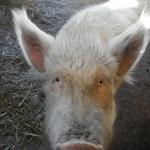 Next we went to see the pigs, the thick-tailed sheep and then milk the cows. We tried first with the small black one. She really didnŌĆÖt want to be milked or perhaps the nine dogs frightened her. On the third attempt she actually jumped over the fence. Then at last to our great relief, on the sixth attempt the herds-men finally got her into one of the stalls, and after all of that she only gave one and a half litres of milk.
Next we went to see the pigs, the thick-tailed sheep and then milk the cows. We tried first with the small black one. She really didnŌĆÖt want to be milked or perhaps the nine dogs frightened her. On the third attempt she actually jumped over the fence. Then at last to our great relief, on the sixth attempt the herds-men finally got her into one of the stalls, and after all of that she only gave one and a half litres of milk.
On our way back from the cows we met one of the staff cycling towards us at full speed.
ŌĆ£Another puppyŌĆØ he blurted out. Sam immediately started sprinting towards reception. The puppy had been born on the couch (luckily the cushions had been taken out for cleaning) and the mother, Ti-Ti was licking it both tenderly and vigorously. After watching for a while I could see it was overall healthy, it was breathing normally, it was warm and it was calling to itŌĆÖs mother.
┬ĀNicolai rushed back to camp to tell Mom and Dad the news, but found them chilling in the spring instead. It took quite a while but he finally persuaded them to come look.
┬ĀIn the meantime Sam told me how three days ago Ti-Ti had had a litter of six still-born puppies and now the survivor had emerged.
A newborn foal that the proud mare presented to us in one of the fields on the way out made my day. It was probably born earlier this morning with his coat still wet.
Kapishiya Hot Springs is a special place of birth, growth and abundance!┬Ā┬Ā




